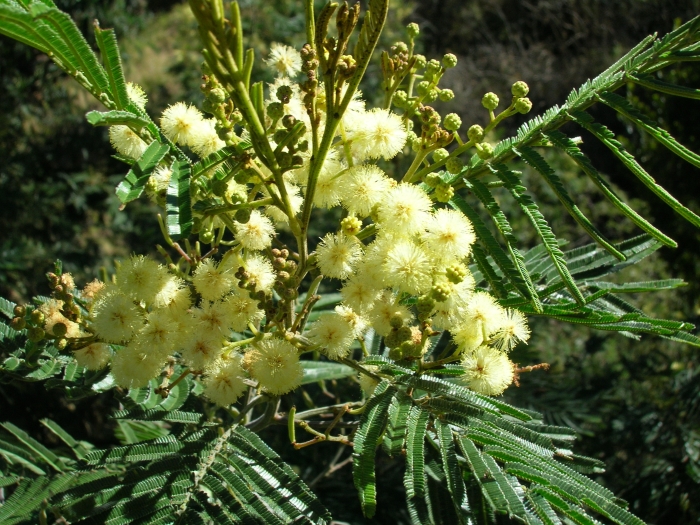Green Wattle
(Acacia mearnsii)
Green Wattle (Acacia mearnsii)
/
/

Forest & Kim Starr
CC BY 2.5
Image By:
Forest & Kim Starr
Recorded By:
Copyright:
CC BY 2.5
Copyright Notice:
Photo by: Forest & Kim Starr | License Type: CC BY 2.5 | License URL: https://creativecommons.org/licenses/by/2.5 | Uploader: Dcarlson | Publisher: Wikimedia Commons | Title: Acacia_mearnsii_blossoms.jpg | Notes: {{Information |Description=Galls on Acacia Longifolia used as a biological control |Source=Observatory Cape Town |Date=January 2007 |Author=Andrew Massyn |Permission= |other_versions= }} A gall-wasp, Trichilogaster acaciaelongifoliae, from Australia, th |













































































Estimated Native Range
Summary
Acacia mearnsii, commonly known as Green Wattle, is an evergreen tree native to open woodlands and forest edges in southeastern Australia. It reaches a typical height of 10 meters (33 feet) and features smooth bark that may become corrugated at the base in older specimens. The bipinnate leaves consist of 7 to 31 pairs of pinnae, each with 25 to 78 pairs of pinnules, and a spherical gland situated up to 8 mm (0.31 in) below the lowest pair of pinnae. The fragrant, pale yellow or cream-colored flowers are grouped in spherical heads of twenty to forty, blooming on hairy peduncles 2–8 mm (0.079–0.315 in) long. Flowering occurs mainly from October to December, and the plant produces black to reddish-brown seed pods, 30–150 mm (1.2–5.9 in) long and 4.5–8 mm (0.18–0.31 in) wide, from October to February.
Green Wattle is valued for its rapid growth and adaptability to a range of soil types, making it useful for erosion control and as a source of tannins for the leather industry. It is also used for ornamental purposes in large gardens and public landscapes. In cultivation, it requires full sun exposure and can tolerate low to medium water conditions, preferring soils with medium to fast drainage. However, Acacia mearnsii is known to be potentially invasive outside its native range, and caution is advised when planting it in regions such as Australasia, China, France, Israel, and the United States. It can outcompete native vegetation and alter ecosystems.CC BY-SA 4.0
Green Wattle is valued for its rapid growth and adaptability to a range of soil types, making it useful for erosion control and as a source of tannins for the leather industry. It is also used for ornamental purposes in large gardens and public landscapes. In cultivation, it requires full sun exposure and can tolerate low to medium water conditions, preferring soils with medium to fast drainage. However, Acacia mearnsii is known to be potentially invasive outside its native range, and caution is advised when planting it in regions such as Australasia, China, France, Israel, and the United States. It can outcompete native vegetation and alter ecosystems.CC BY-SA 4.0
Plant Description
- Plant Type: Tree
- Height: 15-45 feet
- Width: 18-30 feet
- Growth Rate: Rapid
- Flower Color: Yellow
- Flowering Season: Spring, Summer
- Leaf Retention: Evergreen
Growth Requirements
- Sun: Full Sun
- Water: Low, Medium
- Drainage: Medium, Fast
Common Uses
Bee Garden, Bird Garden, Drought Tolerant, Erosion Control, Hedges, Hummingbird Garden, Showy Flowers
Natural Habitat
Open woodlands and forest edges
Other Names
Common Names: Black Wattle, Late Black Wattle, Black Wattle, Tan Wattle, Late Black Wattle, Swartwattel, Gerberakazie, Acacia Negra, Acacia Noir, Acácia-Negra
Scientific Names: , Acacia mearnsii, Acacia decurrens var. mollis, Racosperma mearnsii,
GBIF Accepted Name: Acacia mearnsii De Wild.